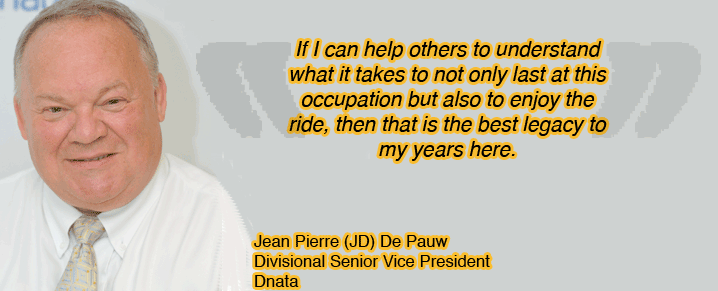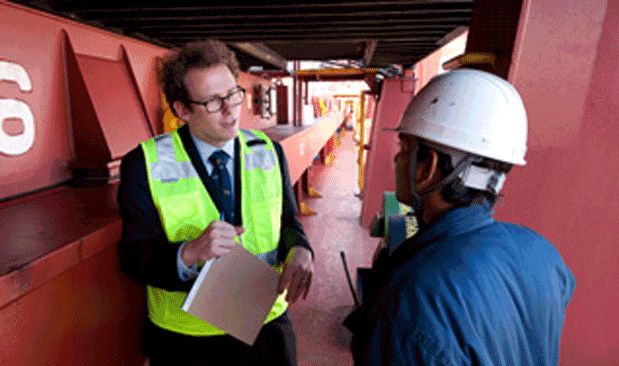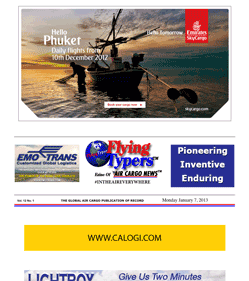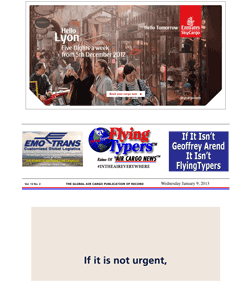|
|
|
 |
As to the condition
of the air cargo
business, JD notes:
“Overall
volumes (OAL only,
not speaking for
EK) were up in
2012 substantially
compared to 2011,
so all in all,
we could say we
are very pleased
with how 2012
progressed.
“Though
on closer examination,
we have to recognize
that pure freighters
are down at DXB,
a result of, on
the one hand,
a combination
of weak markets
and high fuel
prices, with airlines
reducing their
freighter activity
and shifting as
much as they can
to belly cargo
on their passenger
fleets, and on
the other hand,
the rapidly increasing
scarcity of freighter
landing slots
during peak period
at DXB, and finally
the overall continued
weak international
markets.
“As
a consequence,
volumes handled,
especially exports,
at DXB are still
showing a downward
trend with Sea-Air
still a trickle
of what it used
to be.
“On
the bright side,
Dubal World Central
is rapidly profiling
itself as the
place to be for
freighter operators,
scheduled and
charter/project,
and the growth
we have witnessed
there defies all
logic with 19,057
tons handled in
July 2012, a massive
95 percent increase
compared to the
same month one
year ago.
“Looking
ahead, I must
admit that my
crystal ball has
not been very
good to me.
“We
are, like the
rest of the world,
very much dependent
on how the world
economies (and
especially Europe/Asia)
are doing, and
from what I read
in the press from
the experts, they
don’t seem
to be too optimistic,
so I bet on more
of the same.
“One
thing is for certain:
everybody in transportation
will handle the
ups and downs
of the transportation
business by simply
embracing change—change
for the better,
that is…
use the weak market
to get leaner,
meaner, and more
innovative so
when the volumes
return, together
we will be better
prepared to take
advantage of a
growing market.
“For
example, we actually
just finished
what I call ‘the
acid test’—our
annual customer
survey—and
had one of the
highest participation
numbers ever with
very pleasing
results, so we
must be doing
something right.
“As
other years, we
encourage and
welcome the feedback,
positive or negative,
and take appropriate
action where possible,
which we share
with our customers
in our quest to
continue improving.”
But
having delivered
over twenty years
to Dnata, we wonder
what is next in
terms of priority
for JD.
“My
family, and life
after dnata…being
about two years
away and how to
best prepare for
starting that
new career that
will keep my mind
busy…(that’s
another story).
“I
was blessed; there
are not that many
companies and
bosses that will
give you the freedom
of action that
I enjoyed.
“When
I celebrated my
20 years at the
helm of dnata
Cargo in 2011,
I wrote a paper
that I shared
with my management
team. It explains
the highlights
of how I have
‘kept busy
and motivated’
all these years.
“The
idea is: why keep
something that
has worked so
well a secret?
“If
I can help others
to understand
what it takes
to not only last
at this occupation
but also to enjoy
the ride, then
that is the best
legacy to my years
here.
“No
doubt, I will
miss all the excitement
when my time comes
to start afresh
in a new venture
with my family.”
Geoffrey/Flossie
|
 |
Pirates
attacked five
ships at anchorage
at a range of
Indonesian ports
in the last two
months, while
another incident
in neighboring
Malaysia was also
linked to Indonesian
pirates who were
suspected of boarding
a tanker from
a speedboat off
Tanjung Piai.
Twelve crew members
were found tied
up and robbed
when the Coast
Guard rescued
them in mid-September,
according to the
International
Maritime Bureau’s
piracy center.
However,
the most serious
risk to shipping
and the seafarers
that man its vessels
is still to be
found in the waters
reached by mother
vessels operating
out of Somalia,
whose pirates
have shown a willingness
to use violence
and attack large
commercial vessels
on the open seas,
and whose actions
go unmatched by
pirates elsewhere
in the world.
Yet
despite a downturn
in attacks in
recent months,
shipping risk
agency Dryad Maritime
warned that Somali
pirates were not
out of business,
with the high
profits from hijackings
and kidnappings
providing a ready
incentive for
the seamen and
overlords of virtually
lawless and destitute
Somalia to take
to the seas.
“The
threat remains
a very real one;
the capability
is intact and
the motivation
of those engaged
is unlikely to
have been diminished
to the point of
defeat,”
said Ian Millen,
Dryad Maritime
Director of Intelligence.
Dryad
said that as wind
and sea conditions
for skiff attacks
improved, merchant
vessels would
need to be more
vigilant. “Somali
pirates are nothing
if not persistent
and we have seen
some indications
of their continued
attempts to keep
their business
alive,”
said Millen.
“We
could be forgiven
for thinking that
it is ‘game
over’ for
Somali pirates,
beaten into submission
by coalition maritime
forces and frustrated
by the layered
defense of predictive
intelligence,
armed guards,
and effective
physical protection.
“To
do so, however,
would be a big
mistake because
so little has
changed when viewed
through the eyes
of the maritime
criminals in question.
Piracy is a very
lucrative business
and a very attractive
line of work for
young Somali men
who have few other
prospects.
“Those
that organize
and bankroll the
activity are also
unlikely to shut
up shop and invest
their ill-gotten
gains into property
or the travel
industry, and
will be looking
forward to and
hoping for better
times ahead.”
The
warning that greater
vigilance will
be required from
seafarers came
as the Seamen’s
Church Institute,
in collaboration
with New York’s
Mount Sinai School
of Medicine, released
a report on the
psychological
impact of captivity
by pirates.
|
Based
on 154 seafarer
interviews, The
Psychological
Impact of Piracy
on Seafarers found
that most seafarers
did not think
their job was
unduly stressful
under normal conditions,
but starting in
2009 concerns
over piracy, including
anticipatory stress
about transiting
piracy zones,
has been increasing.
The
SCI found that
the frequency
with which seafarers
appealed for armed
guards on board
ships for protection
increased during
the study that
covered 2009-2011.
Of those seafarers
held captive or
attacked by pirates,
most experienced
clinically significant
symptoms afterwards
and less than
a third of these
seafarers felt
that they had
received adequate
follow-up care.
Seafarers
also cited concerns
about disclosing
private medical
records and being
blacklisted as
barriers to receiving
medical care.
“During
encounters with
pirates, seafarers
experience traumatic
events that may
lead to clinically
significant emotional
consequences,”
said Dr. Michael
S. Garfinkle,
SCI’s Clinical
Researcher.
“However,
no attempts to
describe the emotional
circumstances
of seafarers currently
exist to help
in assessing and
treating them.”
SCI
said it would
work with ship
owners to persuade
them to introduce
human resources
protocols that
provide better
post-trauma care.
SkyKing
 |
 |
Ada
Louise Huxtable
died January
7 in New York
City.
|
Get
On Board Air
Cargo News FlyingTypers |
If
You Missed Any
Of The Previous
3 Issues Of FlyingTypers
|
|||||
|
|||||
FT010713 |
FT011113 |
||||
|---|---|---|---|---|---|






 Left to right
Timothy Pfeil,
Vice President,
Sales and Airline
Relations and
Don Cochran Managing
Director of ATC’s
new U.S. subsidiary,
ATC Aviation USA.
Left to right
Timothy Pfeil,
Vice President,
Sales and Airline
Relations and
Don Cochran Managing
Director of ATC’s
new U.S. subsidiary,
ATC Aviation USA.


 Dr.
Garfinkle
speaks
to seafarers
about
impact
of piracy
experience
on their
lives.
Dr.
Garfinkle
speaks
to seafarers
about
impact
of piracy
experience
on their
lives.



